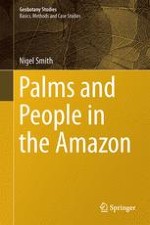2015 | OriginalPaper | Buchkapitel
4. Aphandra natalia
verfasst von : Nigel Smith
Erschienen in: Palms and People in the Amazon
Aktivieren Sie unsere intelligente Suche, um passende Fachinhalte oder Patente zu finden.
Wählen Sie Textabschnitte aus um mit Künstlicher Intelligenz passenden Patente zu finden. powered by
Markieren Sie Textabschnitte, um KI-gestützt weitere passende Inhalte zu finden. powered by
